Ranked amongst one of Japan's most important historical landmarks and a major Buddhist temple in the country, Todaiji (東大寺 Great Eastern Temple) is an attraction that matches the nation's religious devotion in scale and presence.
We almost skipped a pop over to this crowning jewel of Nara because we underestimated the time we would spend with Nara Park's deer and at Kasuga Taisha Shrine, the famous Shinto shrine of lanterns. But thankfully, we made it and were glad we didn't let a non-visit become that thing we regret not doing during a trip.
 |
| Todaiji's Big Buddha Hall (daibutsuden) is the largest wooden building in the world. |
The temple has an understated magnificence that is both commanding yet humble at the same time. It is grand beyond any doubt. But it is also inviting, unassuming, and rather serene despite the throngs of people visiting the sacred site.
Getting to Todaiji - Look Out for Deer by the Water
We came to Todaiji after visiting Kasuga Taisha Shrine by following signposts that pointed the way. The two religious attractions are not too far apart and took us only about 15 minutes to walk between them.
Todaiji's Nandai-Mon (東大寺南大门)
Completed in 1203, the Nandai-mon or Great South Gate has architectural influences from China's Sung Dynasty and is the largest temple gate entrance in Japan. This is the Godzilla of Japanese gates.
 |
| The amount of foot traffic to Todaiji was crazy during our visit which coincided with sakura season. |
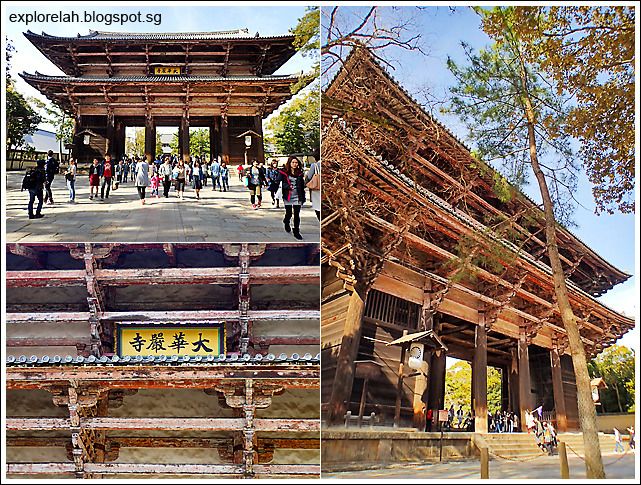 |
| Made entirely out of wood, the original Nandai-mon was destroyed in a typhoon and the current day's structure is a rebuilt version dating back to the 12th century. |
Picturesque Todaiji
I find it fascinating to see how Buddhism is translated into a plethora of architectural styles... from the colourful and ornate jian nian (cut-paste 剪粘) roofings characteristic of China's Chinese temples to the all-seeing eye hallmark of Tibetan temples to the flambouyant gold-gilded wats of Indochine (Thailand, Laos, Myanmar) surrounded by a proliferation of stupas (with the exception of Cambodia's favour for sandstone) to Japan's colour-subdued, minimalist zen approach to temple buildings.
The compounds of Todaiji have a lot of space and an understated beauty that when paired with the season's flourishing sakura blooms, make for postcard-perfect photographs to relish a visit with.
 |
| Passing through Nandai-mon, we came to yet another gate where entrance tickets to Todaiji are sold (¥500 per entry for adults). |
 |
| And finally we got to lay eyes on Todaiji with the sakuras in bloom! The temple compound is very neat and picturesque. |
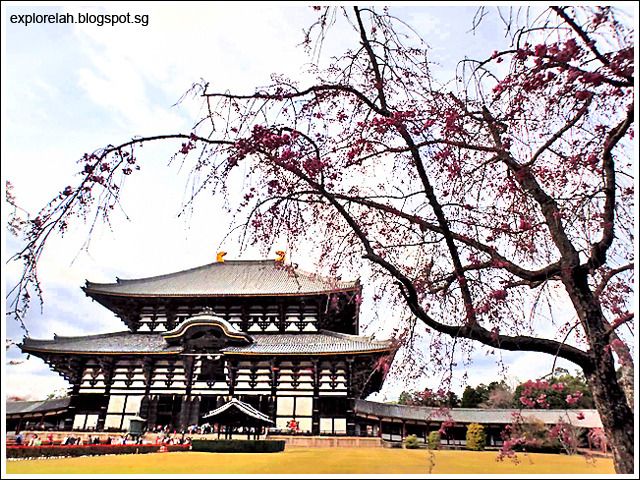 |
| Framing Todaiji with the weeping fuchsia variety of sakura. |
 |
| That essential "I'm here" shot :o) The thing that's as big as the temple is my expanding waistline from all that feasting on Japanese donburis (rice bowl dishes) and ramens (noodles). |
 |
| A intricately carved octagonal bronze lantern greeted us as we got nearer to the temple and I got a closer look at the motifs that adorn the prayer hall's entrance doors. |
 |
| Upper facade of Todaiji Temple. |
Small is not in the vocabulary of Todaiji as everything about it is larger-than-life. Huge gates, big entrances, towering pillars, and gigantic statues... instead of making me feel small, it's as if the temple made me a bigger person just from trying to contain the sight of its sheer size.
Beyond the main prayer hall's entrance door, a collection of massive sacred statues that hold significant cultural as well as historical significance await tourists and devotees. But before entering Todaiji, check out the temple's version of Little Red Riding Hood...
 |
| Om... This Main altar of Todaiji with a 15m tall giant Buddha (Daibutsu) that is one of the biggest in Japan. |
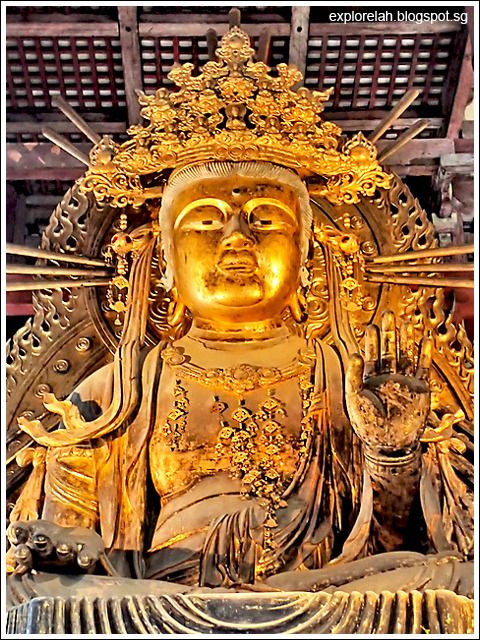 |
| To one side of the giant Buddha is a gilded statue of Kokūzō Bosatsu, the Bodhisattva of wisdom and memory... I sure need lots of these two qualities! |
 |
| In the temple are the remaining two of the Four Heavenly Kings who guard the four cardinal points. This one is Komoku-ten, king of the west and lord of limitless vision who can see through evil. |
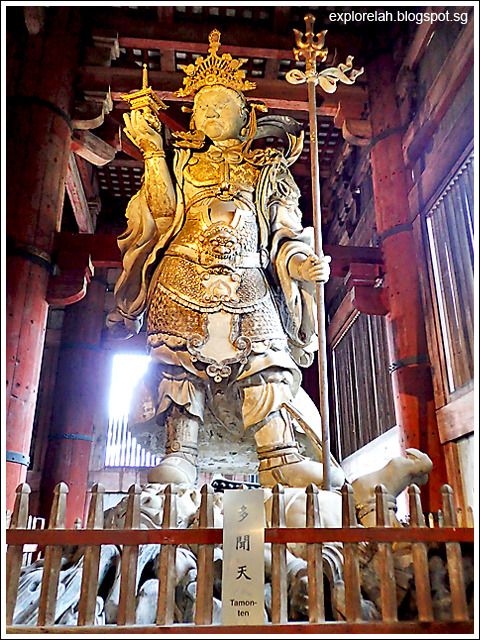 |
| The other Heavenly King in Todaiji is Tamon-ten, king of the north and the lord who hears all. |
 |
| Do you need a helping hand with life's problems? |
 |
| Or give those problems the middle finger and carry on! |
 |
| Bas-relief of Zocho-ten (king of the south, lord of spiritual growth) on the left and right is that of Jikoku-ten (king of the east, guardian of the nation). |
From the towering proportions of Todaiji's religious statues, we now shrink our attention to a hole at the base of one of the pillars in front of the Tamon-ten image.
The hole is the size of Daibutsu's nostril and it is said that if you can squeeze yourself through one side and come out the other side, you will be able to attain enlightenment in your next life. So if you want to attain enlightenment, pretend you're a thread trying to pass through the eye of a needle!
Indeed, it is easier for a camel to pass through an eye of a needle than for a rich man to enter the kingdom of God." This sentiment is also reflected in the Islamic Quran [Verse 7:40] and Jewish sentiments as a metaphor to anything that is impossible...
UNLESS
... "Therefore, whoever humbles himself like this little child is the greatest in the kingdom of heaven." Gospel of Matthew [18:4].
I see a similarity across religions despite the differences in the definitions of who/what is god. It is not easy to get into heaven or achieve enlightenment. It takes humility, not hostility. It requires compassion for fellow humankind, not destruction of innocent lives.
Whoops... there I go again rambling about the interpretations of things I saw instead of providing more useful visitation information about Todaiji. Please pardon me. This Japan trip had been very special for me and I wanted to recount and reminisce every bit of it as a way of reliving, and then recovering from, the depth of my love and filing it as a beautiful memory. If only there's a god to pray the heartbreak away.
Related Posts :
Kasuga Taisha Shrine of Lanterns
Deer Moments at Nara Park

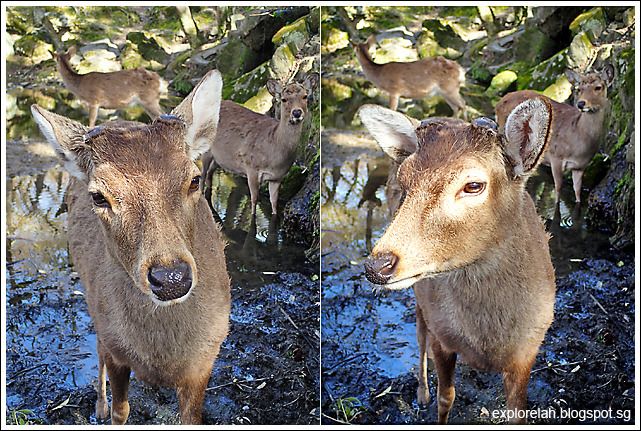







No comments:
Post a Comment